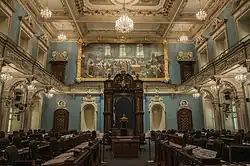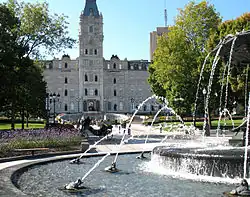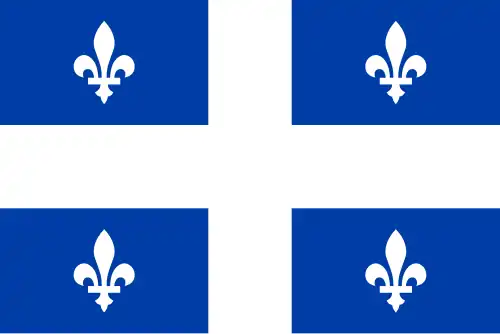National Assembly of Quebec
National Assembly of Quebec Assemblée nationale du Québec | |
|---|---|
| 43rd Quebec Legislature | |
 | |
| Type | |
| Type | |
| History | |
| Founded | December 31, 1968 |
| Preceded by | Legislative Assembly of Quebec |
| Leadership | |
Nathalie Roy since November 29, 2022 | |
Opposition House Leader | |
| Structure | |
| Seats | 125 |
_-_Plan_de_salle_par_parti_(Seating_Chart_by_Party).svg.png) | |
Political groups | Government of Quebec
Parties without official status
|
| Elections | |
| First-past-the-post | |
Last election | October 3, 2022 |
Next election | On or before October 5, 2026 |
| Meeting place | |
 | |
| Parliament Building, Quebec City, Quebec | |
| Website | |
| assnat | |
The National Assembly of Quebec (French: Assemblée nationale du Québec, pronounced [asɑ̃ble nɑsjɔnal dy kebɛk])[2] is the legislative body of the province of Quebec in Canada. Legislators are called MNAs (Members of the National Assembly; French: députés). The lieutenant governor of Quebec (representing the King of Canada)[3] and the National Assembly compose the Parliament of Québec, which operates in a fashion similar to those of other Westminster-style parliamentary systems. The assembly has 125 members elected via first past the post from single-member districts.
The National Assembly was formerly the lower house of Quebec's legislature and was then called the Legislative Assembly of Quebec (French: Assemblée législative du Québec). In 1968, the upper house, the Legislative Council, was abolished and the remaining house was renamed. The office of President of the National Assembly is equivalent to speaker in other legislatures. As of the 2022 Quebec general election, the Coalition Avenir Québec (CAQ) has the most seats in the Assembly.
History

The Constitutional Act 1791 created the Parliament of Lower Canada. It consisted of two chambers, the Legislative Council and the Legislative Assembly. That parliament and both chambers were abolished in 1841 when the Act of Union 1840 merged Upper Canada and Lower Canada into a single province named the Province of Canada. The Act of Union created a new Parliament of the Province of Canada, also composed of a Legislative Council and a Legislative Assembly. That Parliament had jurisdiction over the entire province, with members from Lower Canada and Upper Canada in both houses.
The Constitution Act, 1867 (formerly known as the British North America Act), created the Dominion of Canada, and also created the provinces of Ontario and Quebec by splitting the old Province of Canada into two, based on the old boundaries of Lower Canada and Upper Canada. The act created a new bicameral Legislature for the province of Quebec, composed of the Legislative Council and the Legislative Assembly of Quebec.
In December 1955, the assembly passed a bill according the title "Member of Provincial Parliament" (membre du Parlement provincial) and the initialism "MPP" (M.P.P.) to members of the legislature.[4] Previously, there had been no fixed designation, but they had often been referred to as "Members of the Legislative Assembly" (MLAs) (membres de l'Assemblée législative (M.A.L.s)), which Premier Maurice Duplessis noted in his speech on the bill, "can sometimes be pronounced as 'mal', which means 'evil' in French."[5]
In 1961, Marie-Claire Kirkland became the first woman elected to the Legislative Assembly.
In 1968, Bill 90 was passed by the government of Premier Jean-Jacques Bertrand, abolishing the Legislative Council and renaming the Legislative Assembly the "National Assembly", in line with the more strident nationalism of the Quiet Revolution. Before 1968, there had been various unsuccessful attempts at abolishing the Legislative Council, which was analogous to the Senate of Canada. With the adoption of the new name, members of the assembly were now designated Members of the National Assembly (MNA) in English. In French, they are referred to as either membre de l'Assemblée nationale with the initialism M.A.N.[6] or as députés de l'Assemblée nationale du Québec.[7]
In 1978, television cameras were brought in for the first time to televise parliamentary debates. The colour of the walls was changed to suit the needs of television, and the salon vert (green hall) became the salon bleu (blue hall).
In 1984, Canadian Forces corporal Denis Lortie stormed into the Parliament Building and opened fire, killing three government employees and wounding thirteen others. His intended target was Premier René Lévesque and his Parti Québécois government. However, he was around 15 minutes early and the Assembly floor was still mostly empty; no politicians were shot. He surrendered to police hours later.[8]
Parliament Building

Constructed between 1877 and 1886, the Parliament Building features the Second Empire architectural style[9] that was popular for prestigious buildings both in Europe (especially France where the style originated) and the United States during the latter 19th century.
Although somewhat more sober in appearance and lacking a towering central belfry, Quebec City's Parliament Building bears a definite likeness to the Philadelphia City Hall, another Second Empire edifice in North America which was built during the same period. Even though the building's symmetrical layout with a frontal clock tower in the middle is typical of legislative institutions of British heritage, the architectural style is believed to be unique among parliament buildings found in other Canadian provincial capitals. Its façade presents a pantheon representing significant events and people of the history of Quebec.
In 1936, Maurice Duplessis hung a crucifix in the Legislative Assembly chamber. It hung there for 83 years, until it was removed on 10 July 2019.[10]
Additional buildings were added, adjacent to the Parliament Buildings:
- Édifice André-Laurendeau was added from 1935 to 1937 to house the Ministry of Transport.
- Édifice Honoré-Mercier was added from 1922 to 1925 to house the Ministries of the Treasury (Finance), the Attorney General and the Secretary General of the National Assembly.
- Édifice Jean-Antoine-Panet was added from 1931 to 1932 for the Ministry of Agriculture.
- Édifice Pamphile-Le May added from 1910 to 1915 for the Library of the National Assembly, various other government offices and for the Executive Council.
Elections
General elections are held every four years or less. Since 2014, the legislature has had a fixed four-year term, with elections taking place no later than "the first Monday of October of the fourth calendar year following the year that includes the last day of the previous Legislature."[11] However, the lieutenant governor, acting on the advice of the premier, can dissolve the legislature and call an election earlier. Any Canadian citizen at least 18 years old who has been residing in Quebec for at least six months qualifies to be on the electoral list.[12]
Normally, the lieutenant governor invites the leader of the political party with the largest number of elected candidates to form the government as premier (premier ministre in French; French does not make a distinction between premier and prime minister).
Quebec's territory is divided into 125 electoral districts (ridings). In each riding, the candidate who receives the most votes is elected and becomes a member of the National Assembly (MNA). This is the first-past-the-post voting system. It tends to produce strong disparities in the number of seats won compared to the popular vote, perhaps best exemplified by the 1966 (wrong-winner result), 1970 (false-majority result), 1973, and 1998 election (wrong-winner and false-majority result).
Quebec elections have also tended to be volatile since the 1970s, producing a large turnover in seats. Consequently, existing political parties often lose more than half their seats with the rise of new or opposition political parties. For instance, the 1970 and 1973 elections saw the demise of the Union Nationale and rise of the Parti Québécois, which took power in 1976. The 1985 and 1994 elections saw the Liberals gain and lose power in landslide elections. The 2018 elections saw the rise of the Coalition Avenir Québec, which took power for the first time.
Members
Current standings
Cabinet ministers are in bold, party leaders are in italic and the president of the National Assembly is marked with a †.
Seating plan
Most recent election
Changes during the 43rd Quebec Legislature
| Number of members per party by date |
2022 | 2023 | 2024 | 2025 | ||||||||||||
|---|---|---|---|---|---|---|---|---|---|---|---|---|---|---|---|---|
| Oct 3 | Oct 27 | Dec 1 | Mar 7 | Mar 13 | Mar 29 | Jul 19 | Oct 2 | Apr 16 | Sept 3 | Sept 12 | Mar 17 | Mar 18 | May 2 | Aug 11 | ||
| Coalition Avenir Québec | 90 | 89 | 90 | 89 | 88 | 87 | 86 | |||||||||
| Liberal | 21 | 20 | 19 | 20 | ||||||||||||
| Québec solidaire | 11 | 12 | ||||||||||||||
| Parti Québécois | 3 | 4 | 5 | 6 | ||||||||||||
| Independent | 0 | 1 | 2 | 1 | 2 | 3 | 2 | 1 | ||||||||
| Vacant | 0 | 1 | 0 | 1 | 0 | 1 | 0 | 1 | 0 | |||||||
Proceedings
One of the members of the National Assembly is elected as President of the Assembly (a post called speaker in most other Westminster System assemblies). Any member of the assembly is eligible to stand for election, other than party leaders and Cabinet ministers. The election is the first order of business for a newly elected assembly. It is conducted by secret ballot of all members, with successive rounds of voting if needed before one candidate gains a majority of the votes.[13]
The president of the assembly is the arbiter of the parliamentary debates between the members of the government and the members of the Opposition. In order for a member to address the assembly, the member speak through the president. The president is usually a member of the governing party.
The proceedings of the National Assembly are broadcast across Quebec on the cable television network Canal de l'Assemblée nationale.
See also
- Executive Council of Quebec
- List of Quebec general elections
- List of Quebec premiers
- List of Quebec leaders of the Opposition
- Politics of Quebec
- Timeline of Quebec history
Notes
References
- ^ "Députés - Assemblée nationale du Québec". www.assnat.qc.ca. Retrieved July 27, 2025.
- ^ "Lois Constitutionnelles de 1867 à 1982" (PDF) (in French). Ministry of Justice. January 1, 2013.
- ^ An Act respecting the National Assembly, CQLR 1982, c. A-23.1, s. 2
- ^ "An Act Respecting the Titles of the Members of the Legislative Assembly of Quebec". www.bibliotheque.assnat.qc.ca (in French). December 15, 1955. Retrieved May 25, 2019.
- ^ Débats de l'Assemblée législative. November 17, 1955.
- ^ "M.A.N. (Membre de l'Assemblée nationale) - Assemblée nationale du Québec".
- ^ "Liste des députés de l'Assemblée nationale du Québec" [List of members of the National Assembly of Quebec] (in French). Archived from the original on February 13, 2011.
- ^ "Canadian Parliamentary Review - Article". www.revparl.ca. Retrieved June 13, 2021.
- ^ Useful Information – National Assembly of Quebec. Assnat.qc.ca (October 29, 2012). Retrieved July 12, 2013.
- ^ "Crucifix removed from National Assembly's Blue Room". CBC News. July 9, 2019. Retrieved July 14, 2019.
- ^ An Act to amend the Election Act for the purpose of establishing fixed-date elections, L.Q. 2013, c. 13, s. 3
- ^ "Application for entry on Québec's permanent list of electors". élections Québec.
- ^ La procédure parliamentaire du Québec, 3e édition (Québec: Assemblée nationale du Québec, 2012), pp. 140-147.
Bibliography
- Assemblé nationale du Québec (2000). What is the National Assembly?, Québec: Assemblée nationale, 58 p. (ISBN 2-550-30165-X)
- Deschênes, Gaston (1983). The Assemblée nationale: Its Organization and Parliamentary Procedure, Québec: Assemblée nationale, 53 p. (ISBN 2551047595) [1st ed. in 1977]
